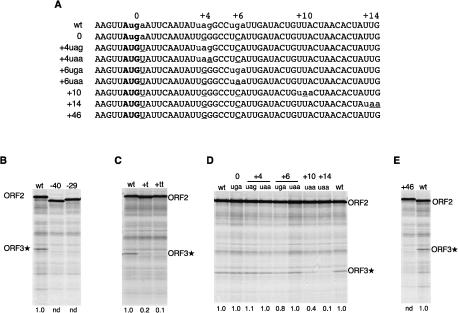Figure 4.
The effect on ORF3* expression of displacing the ORF2 termination codon. (A) Sequences of the ORF2/ORF3* overlap region and the start of ORF3* in the transcripts of the various mutants of pCSFV-2/3* tested. The ORF3* initiation codon is in bold, termination codons are in lowercase, and the introduced mutations are underlined. (B) Translation products of CSFV-2/3* mRNA with UAA stop codons introduced in the ORF2 frame 29 or 40 codons upstream of the wild-type ORF2 stop codon. (C) Products of translation of transcripts of pCSFV-2/3* with one (t) or two (tt) T residues inserted into ORF2 between residues −87 and −88 in the numbering system of Figure 3D. (D) Translation products of the CSFV-2/3* mutants with the ORF2 stop codon displaced up to 14 codons further downstream, as shown in A. (E) Translation products of CSFV-2/3* mRNA lacking the wild-type ORF2 termination codon and the in-frame stop codons at +4 and +6 (shown in A), resulting in an extension of ORF2 by 46 codons. The numbers below each lane show the ORF3*/ORF2 product yield ratio (reinitiation efficiency) obtained with each mutant relative to the wild-type mRNA value set at 1.0. (nd) Not detectable above background (i.e., effectively zero).

